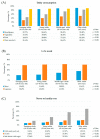Diet Quality According to Mental Status and Associated Factors during Adulthood in Spain
- PMID: 34069704
- PMCID: PMC8160880
- DOI: 10.3390/nu13051727
Diet Quality According to Mental Status and Associated Factors during Adulthood in Spain
Abstract
Common mental disorders (CMD) are characterized by non-psychotic depressive symptoms, anxiety and somatic complaints, which affect the performance of daily activities. This study aimed to analyze prevalence of diet quality among adults with and without CMD from 2006 to 2017, to study the frequency of food consumption and diet quality according to mental status and age, and to determine which sociodemographic, lifestyle and health-related factors are associated with poor/moderate diet quality, according to mental status. A nationwide cross-sectional study was performed in adults with (n = 12,545) and without CMD (n = 48,079). The data were obtained from three Spanish National Health Surveys (2006, 2011/2012 and 2017). Two logistic regression analyses were used to identify factors associated with diet quality in people with and without CMD. Among those with CMD, the probability of having poor/moderate diet quality was significantly lower for overweight or obese people and those who took part in leisure-time physical activity. Among those without CMD, university graduates were less likely to have a poor/moderate diet quality. Good diet quality was observed more in older adults (≥65 years old) than in emerging (18-24 years old) or young adults (25-44 years old), regardless of mental status.
Keywords: age groups; anxiety; depression; diet; mental health; national health and nutrition examination survey; population.
Conflict of interest statement
The authors declare no conflict of interest.
Figures


Similar articles
-
Diet Quality and Sociodemographic, Lifestyle, and Health-Related Determinants among People with Depression in Spain: New Evidence from a Cross-Sectional Population-Based Study (2011-2017).Nutrients. 2020 Dec 30;13(1):106. doi: 10.3390/nu13010106. Nutrients. 2020. PMID: 33396825 Free PMC article.
-
Perception of environmental problems and common mental disorders (CMD).Soc Psychiatry Psychiatr Epidemiol. 2012 Oct;47(10):1675-84. doi: 10.1007/s00127-012-0474-0. Epub 2012 Jan 25. Soc Psychiatry Psychiatr Epidemiol. 2012. PMID: 22273631
-
Lifestyle aspects are associated with common mental disorders in women over 40 years older in a population-based study.Clin Nutr ESPEN. 2024 Dec;64:149-155. doi: 10.1016/j.clnesp.2024.09.021. Epub 2024 Sep 28. Clin Nutr ESPEN. 2024. PMID: 39349105
-
Early Psychological Correlates Associated With COVID-19 in A Spanish Older Adult Sample.Am J Geriatr Psychiatry. 2020 Dec;28(12):1287-1298. doi: 10.1016/j.jagp.2020.09.005. Epub 2020 Sep 7. Am J Geriatr Psychiatry. 2020. PMID: 32951996 Free PMC article.
-
Environmental, Health and Sociodemographic Determinants Related to Common Mental Disorders in Adults: A Spanish Country-Wide Population-Based Study (2006-2017).J Clin Med. 2020 Jul 12;9(7):2199. doi: 10.3390/jcm9072199. J Clin Med. 2020. PMID: 32664638 Free PMC article.
Cited by
-
Mental health and sleep quality: are intuitive eating, hedonic hunger and diet quality, determinants? a cross-sectional study.Malawi Med J. 2024 Jul 30;36(2):80-89. doi: 10.4314/mmj.v36i2.4. eCollection 2024 Jul. Malawi Med J. 2024. PMID: 40191560 Free PMC article.
-
Factors Related to Diet Quality: A Cross-Sectional Study of 1055 University Students.Nutrients. 2021 Oct 5;13(10):3512. doi: 10.3390/nu13103512. Nutrients. 2021. PMID: 34684513 Free PMC article.
References
-
- World Health Organization (WHO) Mental Health Action Plan 2013–2020. [(accessed on 3 January 2020)]; Available online: https://apps.who.int/iris/bitstream/handle/10665/89966/9789241506021_eng....
-
- World Health Organization (WHO) Mental Health Action Programme (mhGAP) Community Toolkit: Field Test Version. [(accessed on 3 January 2021)];2019 Available online: https://apps.who.int/iris/bitstream/handle/10665/328742/9789241516556-en....
-
- World Health Organization (WHO) Depression and Other Common Mental Disorders: Global Health Estimates. [(accessed on 3 January 2021)];2017 Available online: https://apps.who.int/iris/bitstream/handle/10665/254610/WHO-MSD-MER-2017....
-
- GBD 2017 DALYs and HALE Collaborators Global, regional, and national disability-adjusted life-years (DALYs) for 359 diseases and injuries and healthy life expectancy (HALE) for 195 countries and territories, 1990–2017: A systematic analysis for the Global Burden of Disease Study 2017. Lancet. 2018;392:1859–1922. doi: 10.1016/S0140-6736(18)32335-3. - DOI - PMC - PubMed
MeSH terms
LinkOut - more resources
Full Text Sources
Medical

